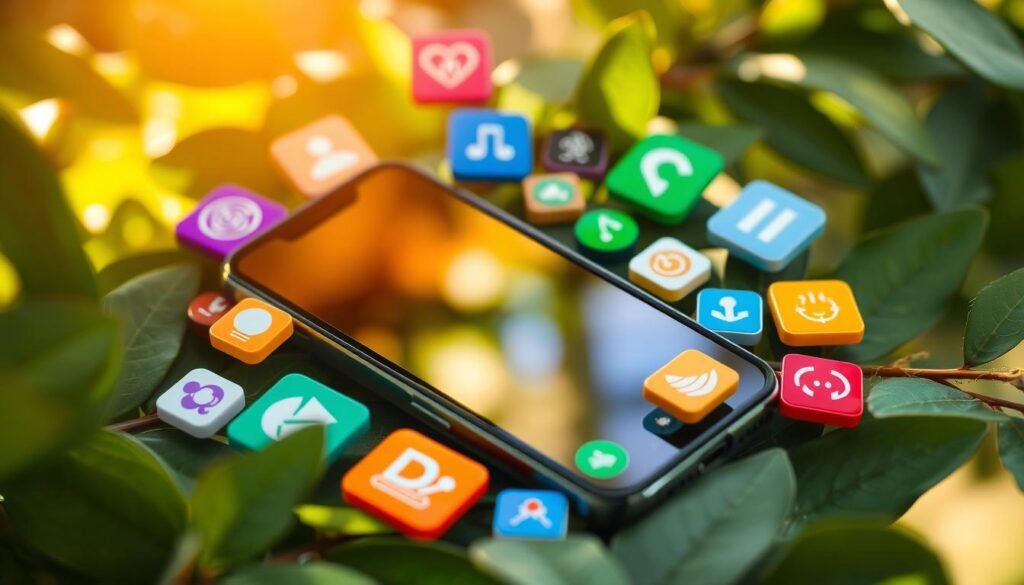Imagine having tools to better your mental, physical, and spiritual health at your fingertips. Digital self-help programs are changing our lives. They offer tools to better sleep, mood, relationships, and overall health. These programs provide everything from apps vetted by doctors to mindfulness practices you can use anytime.
With digital self-help, you can try guided meditations from apps like Calm, which has over 100 options to reduce stress and anxiety1. Or get support anytime with Headspace Care’s 24/7 text-based coaching. These methods let you care for yourself on your own schedule, making personal growth more accessible.
Digital self-help is not a substitute for emergency care but adds value to your health toolkit. It offers ways to stay focused, set goals, and communicate better. The growth of these technologies highlights a move toward managing your own mental health. Check out this link to learn how these tools can help you become more productive.
Key Takeaways
- Digital self-help programs support mental, physical, and spiritual health.
- Apps like Calm offer over 100 guided meditations to reduce stress and anxiety1.
- Headspace Care provides 24/7 text-based emotional support coaching1.
- These programs should complement, not replace, emergency medical care.
- Digital platforms promote self-administered care and increase access to health services2.
Understanding Digital Self-Help Programs
Digital self-help programs use technology to offer personal growth tools. These tools are made by health experts to assist people in overcoming life’s challenges. They aim to improve life quality by providing round-the-clock support and tailored plans.
What Are Digital Self-Help Programs?
Digital self-help programs offer structured guidance through technology. These include stress management apps and platforms for setting goals. Users see better learning methods, more confidence, and higher productivity. A significant move toward digital mental health solutions is noted, especially among youths boosted confidence3. About 83% of relevant studies were thorough trials4.
Benefits of Using Technology for Personal Growth
Technology-driven tools for personal growth have many advantages. They offer constant, personalized support, helping users stay on track. With digital self-help programs, people can set and reach goals at their pace. These programs often lead to better mental health, targeting symptoms like depression and anxiety4. Reports underline the importance of digital methods for young people’s mental health, showing a growing acceptance of self-help technologies4.
The Rise of Mental Health Apps
Mental health apps are gaining popularity as tools for boosting well-being. These apps offer many choices for handling stress and improving mental health5. They provide easy-to-use e-mental health solutions. This makes it simpler to take care of oneself and manage mental health better.
How Mental Health Apps Work
These apps use technology to help users in different ways. For example, some apps give feedback when you enter information, and others track symptoms with phone sensors5. There are also apps designed to enhance thinking skills, important for those with serious mental illnesses5. Apps like Calm and Headspace Care help improve mental states with guided meditations and focus music.

Popular Mental Health Apps to Consider
Among the many e-mental health solutions, Calm and Headspace Care are very popular. They attract 90% of users in the app market6. These apps help reduce stress and make sleep better with lots of guided meditations and music.
Headspace Care is unique for its text support from coaches. This sets it apart by giving users direct help. Meanwhile, Calm offers an immersive experience with its audio content. This content is made for relaxation and mindfulness.
The mental health app sector is always changing, with new apps appearing and old ones going away6. Yet, it’s important to know that the FDA regulates very few apps. Most wellness apps aren’t regulated6. For tips on managing tasks and improving productivity, check out this link.
Exploring Online Therapy Platforms
Online therapy platforms have changed the way people get help with mental health. They became a thing in 2015, starting the era of telepsychology services. Now, they’re a handy option for those who like using the Internet7.
Finding the Right Online Therapist for You
Finding a licensed therapist online is key. This makes sure they can really help you and do it safely7. It’s good to look at their credentials and what other clients say. There are many therapists online, each an expert in different mental health fields8.
This means you can find someone who really understands your personal needs. They provide care tailored just for you, but online.
Benefits of Online Therapy Platforms
Online therapy has lots of benefits. You can choose when to have sessions, which is great if you’re always busy or live far from a therapist7. It also makes getting help possible for people living in distant or underserved areas8.
It’s often cheaper than going to see a therapist in person7. Some places let you use their service as much as you want for a set price each week or month8. Plus, it’s private and easy to access, which many people like8.
However, there are downsides and risks to be aware of. Not all platforms have licensed therapists, and it can be harder to connect without seeing each other’s body language7. But, therapists know how to overcome these issues and create a strong bond with you online8.
| Aspect | Online Therapy | Traditional Therapy |
|---|---|---|
| Accessibility | High – Available from any location | Limited by geographical location |
| Cost | Often lower, with some platforms offering flat weekly/monthly rates | Generally higher due to office overhead costs |
| Privacy | High – Provides greater anonymity | Moderate – Limited by in-person interactions |
| Therapist Quality | Varies – Important to verify licensure | Consistent – Easier to verify qualifications in person |
Online therapy has become well-liked for offering flexibility, affordability, and privacy78. Studies keep showing that it’s an effective way to support mental health. Clearly, online therapy is here to stay and grow.
Advantages of Virtual Counseling Services
Virtual counseling has become very popular because of its many good points. It’s private, safe, and easy to use for mental health help. A big advantage is it cuts out travel. This saves time and tackles the travel issue9.
It’s also great for people who want mental health help from afar. It lets people pick meeting times that fit their busy lives. So, more folks can get help when they need it, bringing mental health care to more people10. About 31% of Americans in therapy now have extra costs like for child or elder care to go to sessions. Plus, 30% can’t find a mental health pro when they need one9. Virtual counseling helps with these problems by giving more time options that work with clients’ schedules.
Also, online therapy businesses have grown a lot in the last few years. Almost a dozen new ones started up. This shows more people want and accept these services10. Studies say online cognitive behavioral therapy (CBT) works as well as in-person therapy for certain conditions9. This proves online counseling is not only handy but also effective.
People using these services say they help cut down on problem gambling. They also might make it easier for folks to seek mental health help by being more private9. Plus, many insurance plans now cover online therapy, making it easier for more people to get9. Online therapy often costs less for therapists too. This can make getting help more affordable9.
Another top benefit is therapists can help people from different places without location being a problem. This helps clients who might not have good mental health care locally. It also lets therapists have a better work-life balance10.
“While virtual counseling is suitable for various situations, it might not be the best option for individuals needing close, in-person treatment or intervention. Text-based therapy may limit the therapist’s ability to accurately interpret non-verbal cues such as facial expressions or body language, which are crucial for effective treatment in some cases.” – [Source]

In short, online counseling benefits are many. It offers a great choice besides traditional therapy. It makes getting mental health support easier, more flexible, and less costly910. By looking at these benefits, people can choose wisely about their mental health care.
AI-Powered Coaching: The Future of Self-Improvement
AI-powered coaching is changing how we see personal development. It’s becoming a key part of the future in self-help. These apps use advanced tech to offer personalized coaching, track goals, and give feedback in real-time.
How AI-Powered Coaching Works
Apps like Rocky.ai use smart algorithms to give personal coaching sessions. This helps with both personal and professional growth. Designed for young professionals, Rocky.ai helps users grow and learn1112. You can join groups, work with many coaches, and focus on up to six leadership skills1112.
AI coaching has many benefits. It offers personalization, it’s easy to access, scalable, gives instant feedback, and is cost-effective1112. These platforms let coaches grow their business while keeping a personal touch11.
https://www.youtube.com/watch?v=DNGPAeX5z40
Top AI Coaching Apps on the Market
There are many AI coaching apps available, each with unique features. Here’s a detailed comparison:
| App | Free Features | Premium Features |
|---|---|---|
| Fingerprint for Success | Basic features | Advanced insights and personalized coaching plans (subscription required)13 |
| Mindsera | Basic journaling | Full mentorship experience (subscription required)13 |
| Clearmind | Initial assessment | Ongoing therapy sessions (paid plan required)13 |
| Chat EQ | Basic features | Advanced training modules (additional cost)13 |
| Quazel | Basic language learning | Full conversational experience (subscription required)13 |
| Lotus AI Therapy | Initial free use | Ongoing therapy sessions (fee required)13 |
| Summit AI Coach | Free trial | Subscription required for continued use13 |
| Accountabilabuddy | Basic service | Premium features (additional costs)13 |
| Pathfinder | Basic features | Comprehensive plan (subscription required)13 |
| Deepen Therapy App | Basic features | Personalized sessions (subscription required)13 |
In summary, AI coaching is making big changes in self-help and personal growth. With AI in these apps, users get coaching that’s tailored to them, easy to access, and highly effective.
Understanding E-Therapy Solutions
The world of mental health care is always changing. Digital therapy options lead the change, making therapy easy to get, flexible, and safe for everyone.

What Makes E-Therapy Unique?
E-therapy stands out by using digital tools like email and video calls for therapy. It lets people stay anonymous, which helps them talk more freely. Also, e-therapy platforms protect patient’s privacy by following HIPAA rules.
More than 15 years of delivering digital therapy to PreK-12 schools shows it works well. This way, kids from busy cities to quiet country areas can get help without travel issues1415.
Choosing Between E-Therapy and Traditional Therapy
Deciding between e-therapy and in-person therapy involves a few key points. E-therapy is great because you can get help from home. It offers live online counseling that fits many needs14. But, some might prefer the closer contact of in-person therapy.
| Factor | E-Therapy | Traditional Therapy |
|---|---|---|
| Accessibility | Available remotely, flexible scheduling | Limited by location, fixed appointments |
| Anonymity | High, can maintain privacy | Lower, face-to-face interaction |
| Security | HIPAA compliant platforms | Confidential in-office sessions |
E-therapy and traditional therapy each have their own benefits, depending on what you need. As tech gets better, digital therapy will become a bigger part of mental health care. This offers many options for everyone.
The Benefits of Self-Guided Wellness Tools
Self-guided wellness tools let people take charge of their health on their own. These digital programs are a big help for managing mental health every day. During the pandemic, 3 out of 4 Americans used more digital tools for mental health16.
These tools help with personal growth and tackle various emotional problems.
Popular Self-Guided Wellness Programs
Some top self-guided programs help with issues like anxiety and depression. Half of the people using them are fighting these mental health problems16. Apps like Calm and myStrength from Kaiser Permanente are free. They help reduce stress and encourage mindfulness16.
These apps have things like visual activities and quizzes that support users fully.
It’s key to know how useful these tools are, with over 10,000 mental health apps available17.
How to Integrate Self-Guided Tools into Your Daily Routine
Adding wellness apps to your day is easy. They cover topics like forgiveness and positivity. About 9% of adults and 26.9% of college students show signs of depression. This shows a wide need for easy-to-use self-care18.
Using these apps often can make a real difference.
It’s good to choose programs that you can start using right away. Sites like this mix motivation with practical steps. They help people reach their dreams16.
Well-chosen self-care apps greatly aid in handling emotions and mental health. They can help many people without big costs17. So, adding them to your daily habits is smart.
Enhancing Your Life with Digital Wellbeing Programs
Digital wellbeing programs are changing how we better ourselves with technology. They play a big role in our daily lives. They help improve our overall life by focusing on our health, mind, and social life.
These programs offer tools to keep an eye on our digital use. They track how much time we spend on apps and help cut down if it’s too much. This is crucial because people touch their phones a lot every day19. Features like Google’s Wind Down make our screens gray at night and stop notifications. This helps us sleep better20.
It’s interesting to see how these apps are made to fit our individual needs and goals. In jobs, limiting unnecessary chats and having no-meeting days can lower stress20. Some features even block annoying alerts during work hours. This helps us stay focused and do better at work20.
Schools also gain a lot from these programs. For example, many medical students in Riyadh use gadgets for studying, despite the health risks19. Detox apps that work with a group, like NUGU, help students use their phones less. They offer support from friends19.
On a larger scale, digital detox can lessen stress and help us sleep and feel better mentally19. The National Day of Unplugging shows us how staying off technology for a day can make us less stressed and happier19. Adding these habits to our daily life can really help us in many ways.
To wrap it up, digital wellbeing programs are key for improving ourselves. They help us manage screen time and encourage us to take breaks from tech. These tools are important for a balanced life. They improve our health and make us happier in today’s digital age.
Tele-Mental Health Resources: A Growing Trend
The way we get mental health care is changing fast thanks to tele-mental health. Between 2019 and 2022, the use of telehealth for mental health jumped from 39.4% to 88.1%21. This big change shows how important it is to look into this online trend more.

Tele-Mental Health Services Overview
Tele-mental health includes video chats and messaging that keep your info safe21. It makes getting medication easier and helps with treatment. For example, during the COVID-19 pandemic, more people in Australia started using these online tools22.
Studies show that getting help online can be as good as seeing someone in person for many mental health problems21. These digital options help break down the walls that make it hard for people to get care. Now, many health professionals can reach their patients easier, no matter where they are21.
Accessing Tele-Mental Health Resources
It’s key to know how to use tele-mental health services. Today, there are many ways to get help online around the world. Studies have found these methods work well for issues like depression and PTSD23.
But, there are hurdles like tech problems and worries about keeping information private21. Bad internet and not having the right gadgets can make it tough for some people to use these services. Yet, more and more people are finding these online tools helpful and easy to use.
If you want help for your mental health online, check out this resource here. It has lots of information on topics like being mindful and growing personally. As online mental health continues to grow, knowing how to tap into these resources is getting more important.
The Role of Mobile Mental Health Applications
Mobile mental health apps are transforming mental health care. They reach over half of those with a mental health diagnosis who own smartphones24. In 2020, around 90,000 health apps were launched, including more than 10,000 for mental health24. This shows the increasing demand for easy-to-access mental health resources.
Mobile Apps for Anxiety and Depression
Many apps focus on anxiety and depression, meeting a need for 70% of people who sought outpatient care and were open to app support in the US25. Apps like Headspace, Calm, and Woebot combine mindfulness, cognitive therapy, and mood tracking. These features aim to offer both quick help and long-term support for anxiety and depression.
Tracking Your Mental Health Progress on Mobile
Mobile apps offer a key advantage: they let you track your mental health. Users can monitor moods, jot down thoughts, and watch for patterns with their healthcare providers. The APA suggests evaluating apps based on privacy, proof, usability, and connectivity24.Peer specialists help by teaching digital skills to access these tools24. Tracking your mental health in this way encourages ongoing, tailored care.
| Feature | Headspace | Calm | Woebot |
|---|---|---|---|
| Main Focus | Mindfulness | Relaxation | CBT |
| Key Functionalities | Meditation, Sleep Stories | Guided Meditation, Sleep Assistance | Mood Tracking, CBT Exercises |
| User Engagement | High | High | Moderate |
Conclusion
At the journey’s end, we see the power of digital self-care. It hugely boosts our personal and mental well-being in today’s busy life. Digital self-help, from smart AI help to online therapy, is changing how we get mental health support. These tools not only help us manage our days and feelings but also keep burnout at bay and help us reach our dreams.
Stories of success from business leaders show us that knowing when to stop and managing time well are key. Resources like the Prioritization Accelerator offer tools like workbooks and videos to grow these skills. Using digital aids more intensely has also helped people feel safer and mentally healthier26.
Web platforms like Alison and Coursera give us ways to learn and grow through webinars and coaching. These opportunities help us find ourselves and fulfill our potential. The growth of digital health tools, with their smart predictions of success, shows us a bright future. This proves technology’s role in improving our mental wellness and growth worldwide27.
FAQ
What are digital self-help programs and how do they enhance mental wellness?
Digital self-help programs are tools and apps reviewed by healthcare experts. They help with mental, physical, and spiritual wellness through easy resources. These programs improve sleep, mood, and relationships.
They offer things like guided meditations and support coaching via text. Users enjoy privacy and effective self-care, with 24/7 support and personalized resources.
How can mental health apps like Calm and Headspace Care help with stress and anxiety?
Apps like Calm and Headspace Care offer easy ways to handle stress and anxiety. They have over 100 guided meditations and sleep stories. Users can also enjoy focus music and text-based coaching.
These apps help people sleep better, reduce anxiety, and improve mental wellness.
What are the benefits of using online therapy platforms?
Online therapy platforms connect you with licensed therapists. They offer flexible schedules and different ways to communicate. It’s personalized, often cheaper, and saves travel time, making mental care more accessible.
What makes virtual counseling services different from traditional counseling?
Virtual counseling offers safe, private, and handy access to mental health support. No need to travel, and scheduling is flexible. It’s easier for people to get the help they need.
How do AI-powered coaching apps contribute to personal growth?
AI coaching apps provide tailored sessions and guide personal growth. They offer instant feedback and adapt to your learning needs. These tools help users reach their goals with innovative support.
What distinguishes e-therapy solutions from traditional therapy?
E-therapy happens through digital communication like email and video calls. It offers anonymity and comfort from home. Knowing these benefits helps choose the best therapy for mental health needs.
How can self-guided wellness tools be integrated into daily routines?
Self-guided wellness tools promote self-care that fits into daily life. They offer modules on different wellness aspects. You can choose resources that match your wellness goals, leading to better well-being.
What are the key benefits of using digital wellbeing programs?
Digital wellbeing programs enhance life quality by focusing on physical, mental, and social health. They use various techniques and supports tailored to users’ needs and goals, offering a complete approach to self-improvement.
How can I access tele-mental health resources?
You can reach tele-mental health resources through telecommunication tech. Services include video consultations and digital chats with professionals. Access depends on guidelines and availability, ensuring proper mental health care when needed.
What mobile mental health apps are effective for managing anxiety and depression?
Mental health apps give quick access to tools for managing anxiety and depression. Features include guided meditations, mood tracking, and exercises. Calm and Headspace Care are popular, helping users watch and better their mental state.
How can I track my mental health progress using mobile applications?
Mental health apps let users track their progress with mood journals, reports, and analytics. This promotes a proactive approach to mental health, helping make smarter care decisions.
